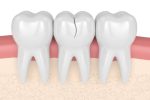
A broken tooth can be a frightening experience, especially if you are worried about losing your tooth! Fortunately, a tooth does not always have to be removed. In many cases, it can be saved with the right treatment. If you are looking for chipped or broken teeth treatment in Grande Prairie, many options available through today’s modern dentistry can repair and protect damaged teeth. The main priority is to return your tooth to function, strength, and appearance.
Now, let’s discuss if a broken tooth can be treated without removal and the options available.
Table of Contents
What can Cause a Tooth to Break?
Anyone can have a broken tooth at any time. The common causes of a broken tooth include:
- Accidentally biting down on something hard (like ice or candy)
- Sports accidents or injuries
- Decayed teeth that made the tooth weak
- Old fillings that can crack or damage
- Grinding or clenching of the teeth at night (bruxism)
By knowing the cause, your dentist in Grande Prairie can keep you in mind to best determine a treatment plan.
Can a Broken Tooth Be Fixed?
In most cases, a broken tooth does not require extraction. With a broken tooth, the treatment options would depend on the size of the break, where the tooth was located, and if there was damage to the inner pulp (the nerves and blood vessels).
What are My Options for Saving a Damaged Tooth?
Dentists have varying processes to save broken teeth. Here are some common ones with simple explanations:
- Dental Bonding
- Used for small chips or cracks.
- Tooth-coloured resin is placed and moulded into shape to look natural.
- A fast and painless option.
- Dental Veneers
- Thin porcelain shells that cover the front of the tooth.
- Works well for chipped or uneven front teeth.
- Improves the look and function of the tooth.
- Dental Crowns
- A protective cap is placed over the tooth.
- Strengthens the tooth and covers a large break.
- Usually done after root canal treatments.
- Root Canal Therapy
- Done only if there is damage or an infection in the pulp inside the tooth.
- Eliminates any infection while maintaining the tooth.
- Usually, a crown is placed afterward for protection.
- Dental Onlays or Inlays
- Used for larger cracks/breaks on the chewing surface.
- Stronger than a filling but covers less surface than a crown.
Here’s a simple comparison:
Problem | Possible Solution |
Small chip | Bonding or veneer |
Large crack | Crown |
Damage to pulp | Root canal and crown |
Chewing surface break | Inlay or onlay |
When is Extraction the Only Option?
- There are occasions when a tooth cannot be preserved. This will usually happen if:
- The crack that runs along the coping edge of the tooth is visible only at the gum line.
- The tooth has severe decay or structural loss.
- There is not sufficient healthy tooth structure remaining to support a crown.
In these situations, your dentist would address your replacement options, which may include dental implants or bridges.
Why Would You Want to Save a Broken Tooth?
When feasible, it is always better to keep the natural tooth. Saving a tooth will help you:
- Maintain chewing function.
- Prevent adjacent teeth from shifting.
- Avoid bone loss in the jaw.
- Maintain your aesthetic smile.
Protect Your Smile with Gateway Dentistry Group
If you are wondering, “Can I save a broken tooth when it doesn’t need to be removed or extracted?” Many times, yes. We can attempt to save a broken tooth by many means of options, Such as bonding, crowns, veneers, and root canals.
At Gateway Dentistry Group in Grande Prairie, we believe in personalized treatment to help you choose the best option based on protecting the natural dentition in your mouth. Don’t wait until there is pain or the issue gets worse. Book your visit to Gateway Dentistry Group today, and learn about the proper option to save your broken tooth!
Take the first step towards a healthier smile, and book an appointment with Gateway Dentistry Group today!








